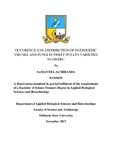Please use this identifier to cite or link to this item:
https://cris.library.msu.ac.zw//handle/11408/3551Full metadata record
| DC Field | Value | Language |
|---|---|---|
| dc.contributor.author | Chibanda, Samantha S. | - |
| dc.date.accessioned | 2019-04-17T14:43:30Z | - |
| dc.date.available | 2019-04-17T14:43:30Z | - |
| dc.date.issued | 2018 | - |
| dc.identifier.uri | http://hdl.handle.net/11408/3551 | - |
| dc.description.abstract | Viruses and fungi are the major threat to sweet potato production because they reduce yield by up to 90% thereby threatening food security. A study was carried out to identify pathogenic viruses and fungi affecting sweet potato and to determine their distribution across varieties and sites in Gweru. A total of 28 samples belonging to five different sweet potato varieties were collected from nine sites in Gweru. Plants were screened for viruses using two methods namely direct observations in the field and the use of Ipomea indica as a test plant. Attempts to use RT-PCR as a confirmatory test was unsuccessful because PCR did not work. Fungal culture on PDA and light microscopy were used for fungi identification. Samples belonging to different varieties were infected by either one of the following viruses or a complex of two of them - Sweet Potato Feathery Mottle Virus (SPFMV), Sweet Potato Chlorotic Stunt Virus (SPCSV), Sweet Potato Leaf Curl Virus (SPLCV) and Sweet Potato Mild Mottle Virus (SPMMV). SPFMV always occurred together with either SPCSV or SPLCV although SPLCV was sometimes found occurring on its own. SPMMV was always found in isolation. Occurrence of the viruses was in the ratio 38:21:20:5 for SPFMV+SPCSV, SPFMV+SPLCV, SPLCV and SPMMV respectively. SPFMV+SPCSV complex was the most widely distributed virus complex. MW variety was the least susceptible to devastating virus complexes such as SPFMV+SPCSV with an incidence of 12.5% but more susceptible to less harmful viruses such as SPLCV with an incidence of 50%. Widespread and spatial distribution patterns of viruses were possibly a result of continuous propagation of infected planting material over time or presence or absence of viral vectors in the different sites. Different fungal colonies that indicated presence of Aspergillus spp, Alternaria alternata, Alternaria bataticola and Fusarium spp were observed on the PDA. Prevalence of fungi was in the range of 5-58 counts for all varieties. Distribution of fungi in all nine sites sampled relies on dispersal mechanisms and moisture availability in the environment as in the case of Fusarium spp. GII and MW varieties were the least susceptible to fungal infections with prevalence of 25% and 13.33% respectively. The results obtained showed association in occurrence of viruses and fungi in sweet potato. This study has revealed that sweet potatoes in Gweru urban are infected by viruses and fungi, which can potentially lower yield by up to 90%. It is therefore imperative for the farmers to adopt control measures such as the use of virus free planting material and use of phytosanitation techniques to minimise post-harvest losses and eventually prevent it completely. | en_US |
| dc.language.iso | en | en_US |
| dc.publisher | Midlands State University | en_US |
| dc.subject | Viruses | en_US |
| dc.subject | Fungi | en_US |
| dc.subject | Sweet potato production | en_US |
| dc.title | Occurrence and distribution of pathogenic viruses and fungi in sweet potato varieties in Gweru | en_US |
| item.languageiso639-1 | en | - |
| item.grantfulltext | open | - |
| item.fulltext | With Fulltext | - |
| Appears in Collections: | Bachelor Of Science In Applied Biosciences And Biotechnology Honours Degree | |
Files in This Item:
| File | Description | Size | Format | |
|---|---|---|---|---|
| FINAL SAMANTHA CHIBANDA FINAL CORRECTED DISSERTATION_04 NOV CORRECTED CORRECTED.pdf | Full Text | 1.64 MB | Adobe PDF |  View/Open |
Page view(s)
176
checked on Apr 5, 2025
Download(s)
106
checked on Apr 5, 2025
Google ScholarTM
Check
Items in MSUIR are protected by copyright, with all rights reserved, unless otherwise indicated.



